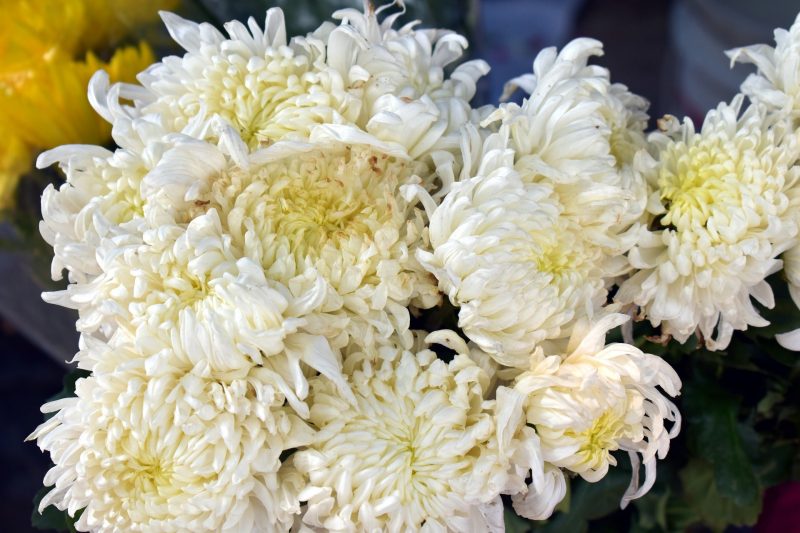Since fall is just around the corner, you probably wondered, “How cold can mums tolerate?” The bright colored mums, pumpkins, and fall leaves are the symbol of fall.
These mums can grow through the winter, but their after-winter growth may be affected. Additionally, the level of protection your mum need from the cold depends on the climate. If you want to know how your mums will fare in varying temperatures, here’s what you should know:

Warm Temperatures
Mum can generally survive warmer temperatures as long as they get enough water. However, heat tolerance usually varies depending on the type of species.
If you live in scorching areas with temperatures ranging from 90 to 100 degrees F, it’s best to plant them in a place where they’ll get some shade during the afternoons. Additionally, it may also be better to plant cultivars that can tolerate heat.
Mum bloom in cold nights, so if the nighttime temperatures are above average in your area for weeks, expect to experience delays in blooming.
Cold Temperatures
Mums are hardy throughout USDA zones 5 to 9, but this can vary depending on the type of species. If we look at the USDA map, you’ll find that mums can survive around (at the lowest) 20 degrees F below zero. This only applies to mums to garden hardy mums with well-established roots that have been planted during the spring season.
Most people plant mums in their gardens just in time for them to bloom during the fall. Keep in mind that mums that are planted in cold winters will not survive because of their shallow roots. If you plant mums in pots, they’ll are more likely to survive as the pots protect them from the cold.
How to Take Care of Your Mums During Winter
To take care of your mums during winter, be sure that you plant your flowers in well-drained soil. Mums are hardy plants, so it isn’t the cold that usually kills them, but it’s when the water in the roots turn into ice. For this reason, it’s essential to plant mums in well-draining soil.
Place your mums in a partially sheltered location to keep them safe from winter winds. Better yet, you can keep them inside a greenhouse to increase their chances of surviving through the winter.
It’s important to properly insulate your mums during the fall season. Once you notice that the leaves have died back after a few touches of frost, you need to cut the stems back at around three to four inches off the ground. Leaving a part of the stem ensures that you’ll have full, healthy mums next year. The shorter you cut the stems, the fewer the regrowth.
As you’re wintering the mums, add a thick layer of mulch (like straw or leaves) over your plants when the ground is frozen. This helps to further insulate your plants and prevents it from thawing. It’ll do more harm than good if the soil repeatedly freezes and thaws. It should remain frozen throughout the winter season.
Why Plant Mums in a Greenhouse?
Planting mums in your backyard is a great idea to spruce up your garden during the winter. However, not everyone has space or the right growing conditions to grow mums. If this is the case, having a mini greenhouse can save the day. Here are a few reasons why you should plant mums in a greenhouse:
Protect your plants from pesky insects
Chrysanthemum aphids, chrysanthemum leaf miners, and two-spotted spider mites are some of the insects that can destroy your mums. Keeping them inside a greenhouse protects them from these harmful insects. Additionally, your plants will also stay safe and protected if there are any infectious plant diseases.
Protect your mums from frost
As you know, mums are hardy, but it’s best to keep them away from frost and freezes. If you don’t want your mums to be subjected to low temperatures, you can protect them by placing them inside a greenhouse or a sheltered area if they’re planted in pots. If you planted them directly into the ground, you could cover them with a sheet board or cardboard.
Start plant growth earlier
Having a mini greenhouse allows you to start growing mums even before the cold season begins or during the cold season. A temperature-controlled greenhouse allows you to alter the climate inside to suit the plants’ specific needs. Once the weather becomes more favorable, you can carefully transplant your mums outside.
Perfect for tender perennial plants
Did you know that mini-greenhouses are great for tender perennial plants as well? Placing your plants inside a greenhouse protects them from frost and snow during the long winter season.
You can transplant them from the garden into pots and keep them inside until spring. Once the weather warms, you can transplant them back into the garden again.
The Bottom Line: How Cold Can Mums Tolerate
So, how cold can mums tolerate? Mums are fairly hardy plants, and they’re relatively easy to grow. If you’re planning to plant mums and have them bloom in the fall season, make sure to keep the tips above in mind for successful planting.
